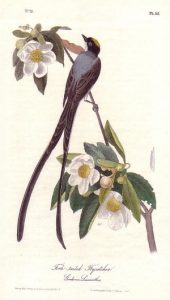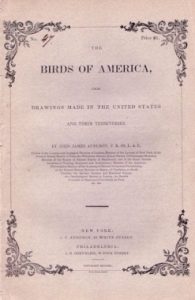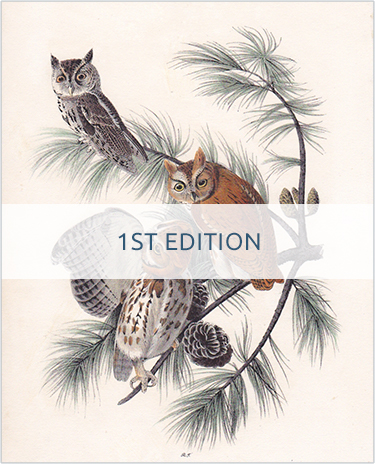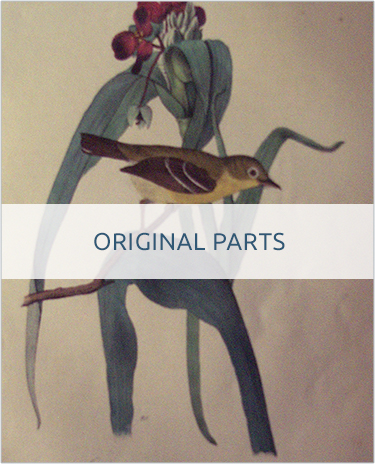 Although the Havell Edition of The Birds of America was a critical success, and covered the Audubon family’s living expenses for many years, Audubon did not make much profit from it. After completing his “Great Work,” he and his family hurried home to America with hopes of producing a more affordable version of The Birds for a broader audience. Settling in New York in 1839, the family almost immediately began producing the royal octavo edition of The Birds in partnership with Philadelphia printer James T. Bowen. Subscription sales of the “Little Work” exceeded expectations, and gave Audubon the means to purchase land and build a home in Manhattan (at what would eventually become 155th St.). As his sons did much of the work to ensure that publication of the octavo edition continued on schedule, Audubon was able to turn his attention to a new folio work on the mammals of North America. Work on the octavo Birds continued until the final number was distributed to the subscribers in 1844. Most were then bound into 7-volume sets of books about the size of a modern-day hard-cover novel.
Although the Havell Edition of The Birds of America was a critical success, and covered the Audubon family’s living expenses for many years, Audubon did not make much profit from it. After completing his “Great Work,” he and his family hurried home to America with hopes of producing a more affordable version of The Birds for a broader audience. Settling in New York in 1839, the family almost immediately began producing the royal octavo edition of The Birds in partnership with Philadelphia printer James T. Bowen. Subscription sales of the “Little Work” exceeded expectations, and gave Audubon the means to purchase land and build a home in Manhattan (at what would eventually become 155th St.). As his sons did much of the work to ensure that publication of the octavo edition continued on schedule, Audubon was able to turn his attention to a new folio work on the mammals of North America. Work on the octavo Birds continued until the final number was distributed to the subscribers in 1844. Most were then bound into 7-volume sets of books about the size of a modern-day hard-cover novel.
The octavo birds differ from the folio birds in several respects. The prints are made using stone lithography rather than etching. The text is bound with the plates, and the birds are presented in systematic order. Each plate includes only a single species while some Havell plates (particularly some of the later plates) include multiple species. In addition, some identification errors were corrected and new species added, resulting in a final total of 500 plates. And of course the smaller size and lower price made this edition a more practical purchase for a broader range of people and institutions.
 Every few months subscribers received several “numbers” (also called parts or fascicles), each number including five plates and text, the number bound with paper covers called wrappers intended for disposal after the numbers had been collated and bound into a volume. Each plate was identified by its plate number on the right and the number from which it came on the left. Thus the five plates from the first number would have “No. 1” printed on the top left side, the next five plates have printed on the left “No. 2,” and on until the last five plates which have “No. 100” printed on the left. Although very rare, some first edition numbers were never bound, and can be found in this form today.
Every few months subscribers received several “numbers” (also called parts or fascicles), each number including five plates and text, the number bound with paper covers called wrappers intended for disposal after the numbers had been collated and bound into a volume. Each plate was identified by its plate number on the right and the number from which it came on the left. Thus the five plates from the first number would have “No. 1” printed on the top left side, the next five plates have printed on the left “No. 2,” and on until the last five plates which have “No. 100” printed on the left. Although very rare, some first edition numbers were never bound, and can be found in this form today.
Audubon’s octavo editions have a complicated publication history that extended from 1839 through 1871 when the last octavo edition was published by George Lockwood. Audubon died in 1851, and so was not directly involved in these publications. This makes the later prints less “collectible” and thus these prints are much less expensive than the comparable first edition prints. The first of the “laters” is the second edition published by Victor Audubon in 1856. Although the text is identical to that of the first edition, the stones used to make the plates often had to be renewed, resulting in changes in lettering and occasionally in the landscape backgrounds or other elements. Most later edition prints have a colored background (called a “tint”) that is comprised of printed (rather than painted) color.
In vertically-oriented prints, the tint is usually a rectangle of color that backs the entire image area (initially a single color, but over time having some variations in tones to suggest clouds). With landscape-oriented prints, the tint is more of an oval and usually includes uncolored or variably colored areas to approximate clouds.The tint color usually ranges from aqua or pale blue to beige or tan. Without knowing the date of the source volume, it is not usually possible to identify the specific edition that is the source of a later edition print, but one can reliably place it within the time frame of the later editions (that is, 1856 to 1871).




